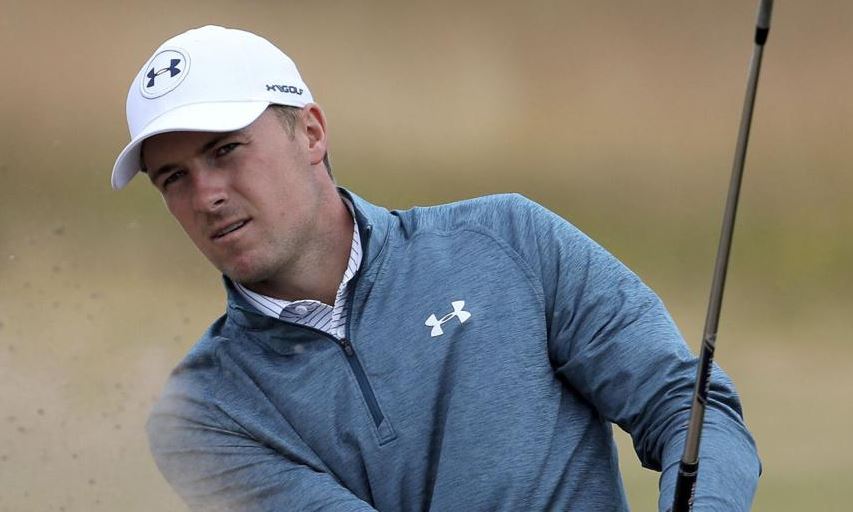Spieth Returns Claret Jug, Faces Tough Task Getting It Back
- Details
-
Category: Inside Golf
-
Published: 2018-07-18
Jordan Spieth Hits Out Of A Bunker During A Practice Round For The British Open. (Richard Sellers/PA via AP)
By DOUG FERGUSON, Associated Press
CARNOUSTIE, Scotland — Jordan Spieth figured someone from the R&A would be waiting for him when he pulled into the parking lot at Carnoustie to take back the silver claret jug. Instead, he was part of a ceremony with enough pomp to drive home the point.
His reign as British Open champion was over.
“The traditions of the Open are very special,” Spieth said, “even if you’re on the wrong end of that one.”
This “tradition” is only a few years old, though typical of the august manner of this major, nothing was left to chance. Spieth was to arrive in a car provided by one of the R&A’s sponsors, and as it drove slowly down a dirt path behind the grandstands on the first hole, cameras moved into position. The door opened and a woman slowly emerged from the back seat. That’s where Spieth would be sitting. This was just a rehearsal to make sure the cameras had the right angle.
Moments later, an R&A employee asked people sitting in the right portion of the grandstands to move to the other side so it would appear fuller.
“It’s the coolest trophy that our sport has to offer,” Spieth said. “So having to return that was certainly difficult. Kind of hit me a little bit there on the tee box.”
It’s far more enjoyable to pose with golf’s oldest trophy — it first was awarded in 1873 — at the 18th hole on Sunday, not the first hole on Monday. That’s the task that awaits Spieth, and it figures to be a monumental one.
Only four players in the last 50 years have repeated as British Open champions, the most recent being Padraig Harrington in 2008.
More than history, it’s the nature of Carnoustie that figures to be the stiffest challenge — or at least on Monday, the most mysterious one. A dry summer has turned the links into a combination of brown (fairways), yellow (wispy rough) and green on the tee boxes and putting surfaces.
That translates into the fastest conditions at an Open since Tiger Woods won at Hoylake in 2006. That was the year Woods hit only one driver — yes, he missed the fairway — and relied mainly on long irons off the tee because the golf ball was running forever.
Early samples indicate this might be just the opposite.
Because the rough isn’t up, and because it’s difficult to judge how far shots will roll out on the fairways, the answer might be to just smash driver over the trouble. Jon Rahm said he planned to hit driver every day on the 396-yard opening hole.
Tommy Fleetwood, who shot 63 at a much different Carnoustie last year during the Dunhill Links Championship, was most perplexed when he reached the 350-yard third hole. It usually is a mid-iron off the tee and a wedge to the green. Now it’s more like a 6-iron off the tee. Or maybe a 7-iron. And even that’s not safe, because the undulations in the fairway could send the ball rolling until a pot bunker gets in the way.
“You feel like on such a short hole, you should have a chance at birdie,” he said. “When actually, you can hit a 6-iron or 7-iron and it ends up in a fairway bunker.”
Spieth couldn’t speak to that because he had yet to see Carnoustie except on television in 2007, and he doesn’t remember much of that, anyway. He was in France over the weekend to see the Ryder Cup courses, and he went to St. Andrews on Sunday as part of the Junior Open.
He recalls Muirfield being fast on Sunday in 2013, his first Open, though that wasn’t nearly as fiery as this course. And even a light rain overnight didn’t change that.
“It doesn’t matter what club you hit. There’s so many holes where you’re going to be taking fairway bunkers on,” Fleetwood said. “You can’t just ... 260 (yards) is just a completely irrelevant number because any amount of clubs can go that far just with it playing that firm.”
The other challenge facing Spieth is this mini-slump he’s in.
He would not have imagined when he left Royal Birkdale last year with that wild finish and his name on the jug that he wouldn’t hoist another trophy. His only close call this year came in the Masters, where he started the final round nine shots behind Patrick Reed and nearly caught him until a bogey on the last hole for a 64. He finished third.
Since then, Spieth has not been closer than 12 shots off the lead in four of the seven tournaments in which he made it to the weekend.
He missed the cut at Shinnecock Hills in the U.S. Open, opened with a 63 at the Travelers Championship and still tied only for 42nd, and then took a break. He went to Seattle to watch his little sister be a cheerleader at the U.S. Special Olympics, and then headed to the Mexico beaches for relaxation and fun golf.
“I needed a break,” he said. “I was kind of dragging along, cut-line golf for a whole, and playing a pretty heavy schedule. ... And coming to an Open Championship requires a lot of feel and imagination, and I think that’s what I needed a bit of in my game.”
And that’s what he most likely needs this week to figure out Carnoustie, along with everyone else.




